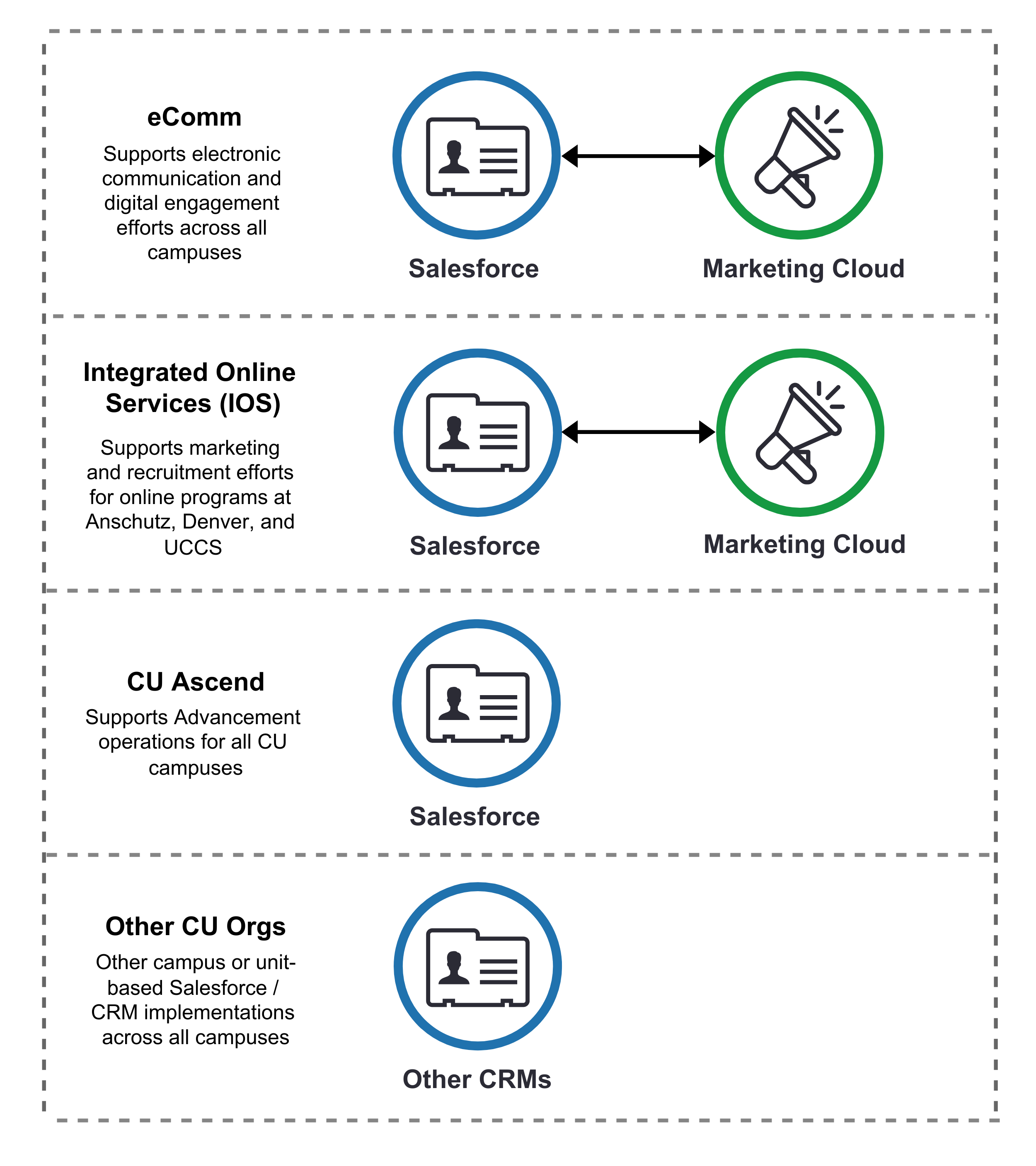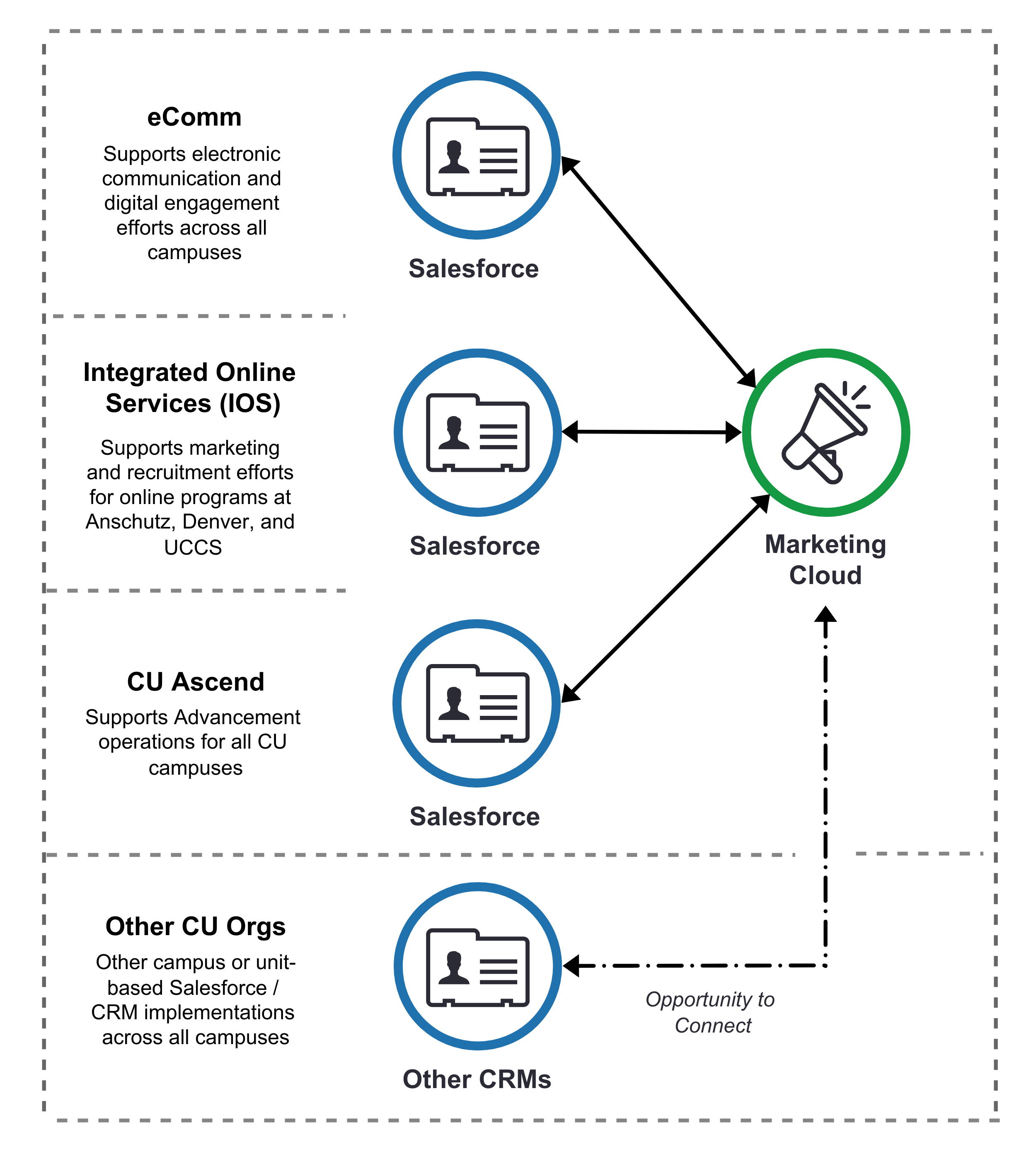Marketing Cloud Consolidation [1]

Latest Updates [2] Contact Us [3]
For nearly a decade, hundreds of CU communicators have relied on the eComm program [4] to effectively engage with students, alumni, donors, faculty, and staff. Using features ranging from single mass email sends to elegant engagement journeys rooted in constituent data and ever-evolving AI features, users sent over 14 million emails to over 80 million constituents in the last year alone. Even with ongoing program growth, however, CU operates in a decentralized CRM environment, and eComm is not the only Salesforce-based home of constituent data. As such, the eComm program is conducting a consolidation to ensure data security, allow for CAN-SPAM compliance and email preference management, and provide opportunities for campus partners to control costs and manage ongoing expenses.
 WHAT & WHY
WHAT & WHY

The current eComm Marketing Cloud environment connects to a single Salesforce org that houses CU constituent data. This Salesforce org, however, is not the only one at CU. Many other Salesforce orgs exist at both System and campus levels, including but not limited to CU Ascend and Integrated Online Services (IOS). While each of these Salesforce environments could connect to its own Marketing Cloud, doing so would result in a duplicative spend of roughly $2 million over five years and would also put CAN-SPAM compliance and a 360-degree view of constituent engagement at risk. The Marketing Cloud Consolidation will combine digital engagement efforts for eComm, CU Ascend, and IOS in a single Marketing Cloud environment that connects to multiple Salesforce orgs and that will allow for connections to additional CRM environments in the future.
 WHEN
WHEN

The Marketing Cloud Consolidation is currently in the planning phase (as of summer '25). The team is working to address critical components of the project including a communication plan and change management, technical architecture and migration scoping, and optimization opportunities related to email preferences. We are also working closely with our account team at Salesforce to explore various options that will position CU to grow its digital engagement efforts responsibly and with an eye toward ongoing optimization and cost control. We expect technical work to begin in fall 2025 and continue in targeted phases through completion in summer 2026.
 HOW
HOW

The consolidation of Marketing Cloud environments will occur in the IOS Marketing Cloud environment, where the ability to connect to multiple Salesforce orgs is already enabled. While this will mean that the entire eComm Marketing Cloud environment will be migrating to a new location, it mitigates serious and highly disruptive risks associated with modifying the architecture of eComm Marketing Cloud to enable a multi-org connection. Once the eComm environment is migrated, we will also work with the CU System Advancement team to enable a connection between the consolidated Marketing Cloud environment and CU Ascend, opening the door to vast improvement and opportunities for Advancement communicators on all four campuses.
 IMPACT
IMPACT

This project will create some changes for eComm users, particularly related to content migration, email tracking data, and data extensions. Impacts will be fully scoped and documented during the project's planning phase, along with plans to manage and minimize disruption to eComm users. We will post regular updates as information becomes available based on the decision making and analysis that is currently underway. For further questions about the impact, see the "FAQ" tab.
MARKETING CLOUD ARCHITECTURE
The current architecture consists of two Marketing Cloud environments (eComm and IOS) connected to two distinct Salesforce orgs. The current CU Ascend Salesforce org does not connect to a Marketing Cloud environment, and there are many other Salesforce / CRM implementations across CU.

The future architecture will consist of a single Marketing Cloud environment (eComm, IOS, CU Ascend) connected to three distinct Salesforce orgs, with the business-critical addition of CU Ascend. The consolidated Marketing Cloud environment will create opportunities for other CRM integrations to support digital engagement.

PLANNING PHASE
The planning phase of the Marketing Cloud Consolidation is scheduled to occur between April and August 2025, with core, topic-based work occurring as follows:
April 2025
- Determine which Marketing Cloud environment will be used for the consolidation
- Complete of formal project request in University Information Services (UIS)
- Present project request to UIS Leadership Team
- Obtain approval to begin planning from UIS Leadership Team
May 2025
- Review contract renewal options and conduct transition planning discussions with vendor
- Identify and document project roles and responsibilities
- Prepare for and host kick-off meeting
- Determine level of consolidation possible in the project
June 2025
- Review contract renewal options and conduct transition planning discussions with vendor
- Identify and confirm additional budget that may be required
- Develop communication plan
- Document and hand-off Advancement-specific work requirements to CU Ascend team
- Discuss business unit structure
- Discuss bulk sender compliance needs
July 2025
- Discuss email preference model
- Discuss user and subscriber management
- Discuss data extension model
August 2025
- Present project to UIS Design Review Committee (DRT)
- Finalize project execution timeline
- Present final project execution plan to UIS Leadership Team
- Obtain UIS Leadership Team approval to begin execution phase
- Execution phase begins
EXECUTION PHASE
The exact timing of the execution phase is still in development but will be available in early- to mid-August 2025. At a high level, we expect the execution phase to begin in August 2025 and run through summer 2026.
FAQ
While we do our best to anticipate all of the questions you might ask, we recognize that we likely did not capture all of them. If you have a question or concern not addressed below, please reach out to us [3] for assistance.
Will this project require any down time for current eComm and IOS users?
Although the project will require a hard cutover between Marketing Cloud environments, our goal is keep any downtime at a minimum and to ensure it occurs outside of normal business hours. Any down time that will be required will be communicated in advance to minimize disruption.
Will this project reduce the eComm user fee?
While this project may not substantially reduce the eComm user fee, it will provide us with better cost control and expense management in addition to reducing duplicative spend. More users in the consolidated Marketing Cloud environment may result in some cost reduction, and we will have more information on FY27 costs in spring of FY26.
Will I be able to keep all my current eComm content in Marketing Cloud?
During the planning process, we will identify a transition plan for some (not all) of the content eComm users have in Marketing Cloud today. Current content now spans almost a decade, so we will not be migrating all content in every business unit. We will, however, communicate with you as decisions are made and as a process is identified so that you can plan ahead.
Will I lose my eComm tracking data?
Following the consolidation, previous eComm tracking information that was housed in Marketing Cloud will no longer be available in the new environment. However, all send tracking data is stored in an external system within UIS for seven years post-send, so data will be available if there is an urgent need. We will communicate with you about the timeline associated with tracking data changes and will provide information on when and how to export your existing tracking data directly from Marketing Cloud if desired.
Will there be changes to how I build and send emails?
We expect that there will be some small process changes related to how you will send your emails in the consolidated Marketing Cloud environment. We are scoping and documenting all changes during the planning phase of the project and will provide information about relevant changes as soon as it becomes available. Additionally, we will support our users with updated training and documentation for any process changes that occur as a result of the consolidation.
PROJECT TEAM & STAKEHOLDERS
Project Team
CU System University Information Services
- Jennifer Mortensen, Director of CRM
- Jeff Benn, Assistant Director of CRM
- Lauren Galena, Senior Analyst
- Megan Harris, Senior Program Success Analyst
- Melanie Jones, Training and Enablement Lead
- Samantha Moreno, Senior Project Manager
- Claire Palmquist, Digital Engagement Manager
- Nonie Roberts, Senior Digital Engagement Administrator
- Daniella Torres, Senior Salesforce Administrator
eComm Specialists
- CU Advancement
- Serwaa Adu-Tutu, Digital Marketing Senior Professional
- Maddie Taylor, Digital Marketing Specialist
- CU Anschutz
- Kelly Miller, Communication Program Manager
- Hannah Schlueter, Digital Communications Specialist
- CU Boulder
- Lissa Cordova, eCommunications Director
- Nicole Janosi, eCommunications Professional
- Ranier Lolly, eCommunications Specialist
- Tom Needy, Senior Marketing Operations and User Experience Strategist
- CU Denver
- Emilia Covault, Senior Operations Specialist
- UCCS
- Eric Nissen, Director of Marketing and eCommunication
CU Advancement Stakeholders
- Luc Maker, Executive Director of Advancement Data and Technology
- John Radcliffe, Salesforce Solutions Architect and Manager
- Tim Skillern, Assistant Vice President for Central Advancement
- Geoff Whaley, Director of Annual Giving and Digital Marketing
CU Anschutz Stakeholders
- Terri Carrothers, Executive Vice Chancellor for Administration and Finance and CU Anschutz Chief Financial Officer
- Kathy Green, Vice Chancellor of Marketing and Communications
- Nicole Lawrence, Communication Director
- Ryan Nisogi, Assistant Vice Chancellor for Marketing and Strategic Communication
- Chris Smith, CIO and Vice Chancellor for Information Strategy and Services
CU Boulder Stakeholders
- Erin Frazier, Assistant Vice Chancellor for Constituent Engagement
- Todd Haggerty, Vice Chancellor and Chief Financial Officer
- Jon Leslie, Vice Chancellor for Strategic Communications
- Marin Stanek, Vice Chancellor of Information Technology
CU Denver Stakeholders
- Tammy Ewin, Vice Chancellor for Marketing and Communications
- Will Kubie, Interim Assistant Vice Chancellor for Marketing and Digital Strategy
- Ann Sherman, Executive Vice Chancellor for Finance and Administration
- Vacant, Vice Chancellor of Technology, Strategy and Innovation and Chief Technology Officer
UCCS Stakeholders
- Harper Johnson, Assistant Vice Chancellor for Information Technology and Chief Information Officer
- Kathy Kaoudis, Vice Chancellor of Administration and Finance
- Chris Valentine, Assistant Vice Chancellor for Marketing and Communications
System Stakeholders
- Michele Ames, Vice President for Communication